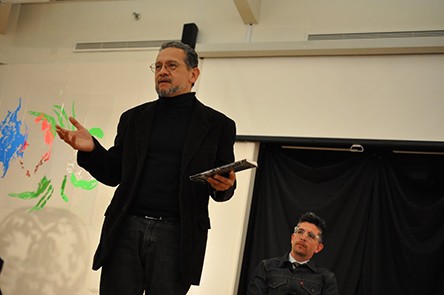A recent event in Boyden Gallery, Latin American poets read their original works in Spanish, and ILC students present their translations in English.
Archives for October 2014
Program Highlight: International Languages and Cultures
Interview with Katherine Gantz, department chair
What concentrations are available to ILC majors and minors?
KG: The Department of International Languages and Cultures offers language study in Chinese, French, German and Spanish. During the 2014-2015 academic year, ILC will offer major and minor concentrations in Chinese, French, Latin American Studies and Spanish.
Our program is innovative in that our students major or minor in international languages and cultures with a concentration in a particular area, instead of choosing a singular major or minor in Spanish or Chinese, for example. This curriculum provides an expansive design – students become global citizens, focusing on the interworking elements of a culture. In addition to rigorous language study in their concentration, ILC majors are required to take at least one course in a language different from their concentration, along with classes in culture, civilization, and literature. This is capped off by a St. Mary’s Project that allows them more intense exploration of a particular passion in their chosen field.
What should new students know about the Department of International Languages and Cultures?
KG: Averaging over the last four years, ILC is the 4th largest minor at the college, and the 9th largest major; clearly, SMCM students not only seek out our classes, but also flourish in them. A huge part of that success is our superb faculty. The Department of International Languages and Cultures boasts published poets, translators and award-winning authors. Faculty are scholars in comparative literature, gender theory, and linguistics, and two faculty have been awarded the Homer L. Dodge Award for Excellence in Teaching. In ILC classes, our students have the opportunity to view international cultures through an impressive array of lenses.
How does study abroad affect ILC students?
KG: The Department of International Languages and Cultures has taken the time to evaluate our international programs very carefully; we’ve built strong ties with our study abroad partners to ensure that their cultural and curricular value measures up to our own high departmental benchmarks.
The exciting thing for ILC students who study abroad is that they find their coursework prepares them for a whole different level of function and engagement. Classes in ILC help make international education an active experience.
What do ILC students want to pursue post graduation/where do alumni end up?
KG: In the short term, many ILC grads frequently have jobs or internships overseas, including Peace Corps work, or teaching English abroad.
Beyond that, we find our alumni tend to find jobs that make use of aptitudes cultivated in ILC: critical thinking, strong communication skills, cultural awareness and the ability to navigate difference and ambiguity. Below is a partial list of some of the most common employment areas for ILC alumni:
- international development
- strategic communications
- immigrant outreach
- project management
- ESOL or international language teaching
- public health
- government and public service
Why do all the majors take an Introduction to Cultural Studies course?
KG: The course analyzes the links between language, culture and meaning. The course not only guides our students toward competent and sensitive intercultural communication, but also helps them sharpen their critical thinking skills. The goal with this course is to provide students with a theoretical toolbox to explore and analyze cultural objects, such as texts, film, histories, music and customs, within the cultures they study. This theoretical framework allows our students to understand that cultural expression, including language, is socially constructed and constantly evolving. After taking the cultural studies course, students understand that language is a powerful tool that not only allows us to communicate with one another, but also shapes the way we perceive the world around us.
How do ILC students get involved in the local community?
KG: One vivid example is Professor Bartow’s recent “Spanish in the Community” course. Students at the 200- and 300-level met for a total of 33 classes throughout the semester, and then they spent eight days alternating between in-class instruction and volunteering as tutors at local elementary schools. Students in the class studied a host of immigration issues, including how immigration affects local Latino families and their children’s ability to receive a quality education, as well as the cultural differences between Hispanics and other groups of Americans. As its namesake implies, community engagement was a major aspect of the course. Students committed to one to two hours of individualized tutoring a week with children and parents at their assigned local schools.
What are some examples of ILC SMP topics?
KG: Our SMPs cover many topics across the globe and reflect both our students’ individual interests and our desire for them to tackle the complex challenges and opportunities presented by globalization. Many SMP topics reflect the interdisciplinary nature of our work, as well as the success of our double majors in combining ILC coursework with other disciplines.
Recent ILC St. Mary’s Projects include:
- “Underlying Geometries within Islamic Mosaics and Islamic Influence in the South of Spain”
- “The Legacy of Colonization in Urban Space: The Transformation of French Immigrants in the 20th and 21st Centuries”
- “Ostrock: The Complex Relationship between the East German Government and Its Subversive Rock Musicians”
- “Straight to the Source: China’s Single Children Offer Insight into the Reality of the One-Child Policy”


